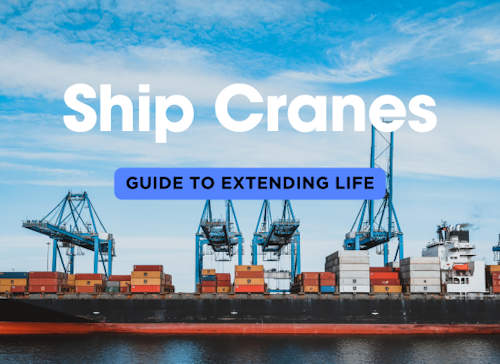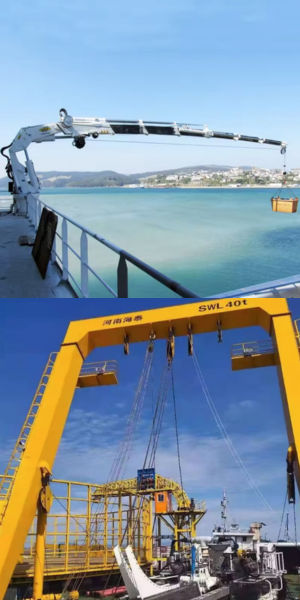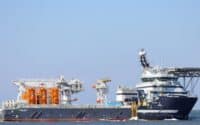Extending the life of Ship Cranes: A Comprehensive Guide

Extending the life of ship cranes is crucial for maintaining efficiency and safety on board. Cranes used in maritime environments are exposed to harsh conditions, such as saltwater, high winds, and heavy loads, all of which contribute to wear and tear. Implementing a regular maintenance schedule, along with best practices for upkeep, can significantly prolong the life of these essential machines. In this guide, we'll break down the key components that require frequent inspection, explain why routine servicing is vital, and offer practical advice on scheduling maintenance to maximize your crane’s lifespan.
| ShipUniverse: Top 10 Tips for Extending the Life of Ship Cranes | |||
|---|---|---|---|
| Tip | Why It’s Important | Actionable Steps | Frequency |
| 1. Regular Inspections | Identifies wear and tear early to prevent major breakdowns. | Follow a detailed inspection checklist, focusing on critical components like cables, hydraulics, and structural integrity. | Every 3-6 months or after heavy use. |
| 2. Proper Lubrication | Reduces friction and prevents damage to moving parts. | Apply marine-grade grease and lubricants to bearings, gears, and joints. Clean parts before lubrication to avoid contamination. | Every 1-3 months depending on usage. |
| 3. Adhere to Load Limits | Overloading causes stress on the crane’s structure and mechanical systems. | Always consult the crane’s load chart and never exceed its rated capacity. Train operators on proper load management techniques. | Ongoing, every lift operation. |
| 4. Protect from Corrosion | Corrosion weakens the crane’s structure, leading to early failure. | Apply anti-corrosion coatings, use stainless steel parts where possible, and ensure proper drainage to avoid water pooling. | Inspect for corrosion every 6-12 months, reapply coatings as needed. |
| 5. Train Operators Regularly | Properly trained operators reduce operational errors that can damage the crane. | Ensure operators have up-to-date certifications and provide ongoing training to keep skills sharp. | Every 1-2 years, with refresher courses as needed. |
| 6. Perform Load Testing | Ensures the crane can handle its maximum rated load safely. | Conduct load tests under controlled conditions, and inspect components afterward for any signs of stress or failure. | Annually or after any significant repair or modification. |
| 7. Keep Spare Parts on Hand | Having parts readily available reduces downtime and ensures timely repairs. | Stock critical spare parts like cables, hydraulic seals, and brake pads. Use genuine parts to maintain crane performance. | Ongoing; restock after every use. |
| 8. Manage Hydraulic Systems | Hydraulic system failures can halt crane operations and lead to costly repairs. | Regularly check hydraulic fluid levels, replace hoses as needed, and monitor for leaks. | Inspect every 6 months; replace fluid annually or per manufacturer guidelines. |
| 9. Upgrade Electrical Systems | Outdated electrical systems can fail and affect crane operation. | Upgrade control systems, relays, and wiring as needed. Use waterproof enclosures and corrosion-resistant materials. | Every 5 years or when performance declines. |
| 10. Ensure Proper Storage | Improper storage leads to rust, corrosion, and environmental damage. | When not in use, protect the crane with covers or shelters, especially during harsh weather conditions. | Store properly after every use; check condition before operation. |
Maintenance Schedules
A well-planned maintenance schedule is essential to ensuring the long-term performance and safety of ship cranes. Regular maintenance not only prevents unexpected breakdowns and costly repairs but also extends the operational life of the crane by addressing wear and tear before it becomes critical. By staying on top of routine inspections, lubrication, and component replacements, ship owners can maintain peak efficiency, reduce downtime, and ensure safe operations for both crew and equipment.
| ShipUniverse: Regular Maintenance Schedules | |||
|---|---|---|---|
| Task | Importance | Components to Check | Maintenance Best Practices |
| Routine Inspections | Routine inspections help identify early signs of wear, preventing major failures that could lead to costly repairs or accidents. Regular checks also ensure compliance with safety standards. | Cables, bearings, hydraulic systems, electrical wiring, control systems, crane boom, and load-bearing components. | Schedule inspections at least every 3 months. Create a detailed checklist for each component. Keep a maintenance log for future reference. |
| Lubrication of Moving Parts | Proper lubrication prevents friction and wear on moving components, significantly extending their lifespan. | Bearings, gears, pulleys, cables, and joints. | Lubricate all moving parts at least once a month, or more frequently if the crane is used heavily. Use marine-grade lubricants to protect against saltwater corrosion. |
| Hydraulic System Check | The hydraulic system is essential for the smooth operation of the crane. Any issues here can lead to operational delays or crane failure. | Hydraulic fluid levels, hoses, seals, pumps, and filters. | Inspect the hydraulic system every 6 months. Replace hydraulic fluid and filters according to the manufacturer's guidelines. Look for leaks and address them immediately. |
| Structural Integrity Inspection | Ensuring the crane’s structural components are free of cracks, rust, or fatigue is critical to avoid catastrophic failure. | Crane boom, load-bearing arms, joints, and welds. | Inspect for any signs of fatigue, rust, or cracks every 12 months. Apply protective coatings as needed. Reinforce weak spots or replace damaged components. |
| Electrical Systems Check | Faulty electrical systems can lead to downtime or accidents, making regular checks essential. | Control panels, wiring, relays, sensors, and fuses. | Conduct electrical system checks every 6 months. Ensure all wiring is corrosion-free and properly insulated. Replace any faulty components immediately. |
| Load Testing | Load testing verifies the crane’s ability to lift safely under maximum conditions, ensuring it complies with safety regulations and is not compromised under stress. | Load-bearing structures, hydraulic systems, cables, and control systems. | Perform load tests annually or after any major repairs. Document the results and take corrective actions if the crane shows signs of strain or failure. |
| Corrosion Control | Corrosion can weaken key components, leading to structural failure if left unchecked. | Steel surfaces, joints, bolts, and load-bearing components. | Apply anti-corrosion treatments at least once a year. Inspect for rust spots monthly and treat them immediately to prevent spreading. Use protective coatings specifically designed for marine environments. |
Proper Lubrication Techniques
Maintaining proper lubrication is key to ensuring that a ship’s crane continues to function smoothly and reliably over time. Without proper lubrication, moving parts can wear out quickly, leading to costly repairs or complete crane failure. Below is a breakdown of recommended lubrication techniques and best practices:
- Recommended Lubricants for Crane Components:
- Use marine-grade lubricants specifically designed for equipment exposed to saltwater and harsh environments.
- Lithium-based greases are ideal for most moving parts like bearings and joints, as they provide excellent water resistance.
- For hydraulic systems, use high-grade hydraulic oils that meet manufacturer specifications and are resistant to thermal breakdown.
- Synthetic oils can be used in extreme temperature conditions for added protection against wear.
- Frequency and Application Methods for Key Parts:
- Bearings and Gears: Lubricate monthly or after 100 hours of operation. Apply grease with a grease gun to ensure full coverage without over-lubrication.
- Cables and Pulleys: Lubricate every 1-3 months, depending on usage. Use a cable lubricant applicator tool to apply the lubricant evenly and prevent buildup.
- Hydraulic Systems: Inspect hydraulic oil levels regularly and replace every 6 months or as recommended by the manufacturer. Always use clean, filtered oil to avoid contamination.
- Joints and Pins: Lubricate every month or after every heavy-use period. Ensure proper coverage but avoid over-greasing, which can trap dirt.
- Avoiding Over-Lubrication or Contamination:
- Over-lubrication can cause excessive buildup of grease, which traps dirt and debris, causing abrasion over time.
- To avoid over-lubrication, use the correct amount specified in the crane’s maintenance manual and stop once resistance is felt during application.
- Always ensure lubrication points are clean before applying new lubricant. Wipe away excess grease to prevent contamination and buildup.
- Use only high-quality lubricants as lower-grade oils and greases can break down faster, leading to early wear of parts.

Factory Direct Pricing = Huge Savings
* High-end cranes trusted by top fleets.
* Fully customizable according to your specs.
* Marine cranes, including gantry, deck, knuckle boom, telescopic, and jib cranes, to meet all your maritime needs.
| Deck Crane | Gantry Crane | Overhead Crane | Container Carrier | Knuckle Boom |
|---|---|---|---|---|
| 10k to 80k | 20k to 50k | 30k to 60k | 40k to 70k | 15k to 40k |
Correct Load Management
Managing the load correctly is essential to extending the life of a crane. Overloading or improper distribution of weight can lead to equipment failure or safety hazards. Below are some best practices for load management:
- Ensuring Adherence to Crane Load Limits:
- Always refer to the crane’s load chart to determine the maximum weight it can safely lift. This chart is based on the crane’s configuration and should never be exceeded.
- Regularly inspect the load limit indicators to ensure they are functioning correctly.
- Educate crane operators on the importance of load limits and the risks associated with overloading.
- Strategies for Evenly Distributing Weight:
- Balance the load properly across the crane’s boom. Ensure that the center of gravity is directly under the hoist to prevent swinging or tipping.
- Use spreader bars or slings to distribute the weight evenly across the crane’s lifting points.
- For uneven or bulky loads, adjust the crane’s positioning to minimize strain on any one part of the structure.
- Effects of Overloading on Crane Longevity:
- Overloading puts extreme stress on the crane’s hydraulic systems, cables, and structural components, leading to accelerated wear and the potential for catastrophic failure.
- Repeated overloading can cause metal fatigue, leading to cracks in key parts such as the boom and load-bearing arms.
- In the long run, consistently overloading the crane shortens its operational life, increases maintenance costs, and poses significant safety risks.
| ShipUniverse: Common Parts and Replacement Intervals | |||
|---|---|---|---|
| Part Name | Expected Lifespan | Replacement Interval | Additional Information |
| Cables | 1-2 years | Annually or after 1,000 hours of operation | Cables are prone to wear from both mechanical stress and saltwater exposure. Regular inspection and timely replacement are key to preventing failures. Always use marine-grade cables with anti-corrosion coatings. |
| Bearings | 3-5 years | Every 3 years or sooner if signs of wear appear | Bearings are critical to the smooth rotation of moving parts. Ensure they are properly lubricated and free of dirt or debris to maximize their lifespan. Noise or vibration can indicate wear and a need for replacement. |
| Hydraulic Hoses | 5 years | Every 5 years or if cracks or leaks appear | Hydraulic hoses are exposed to high pressure and can deteriorate over time due to environmental conditions. Regularly inspect for cracks, leaks, or stiffness, and replace immediately if any signs of damage are found. |
| Hydraulic Fluid | N/A | Every 6-12 months | Hydraulic fluid should be replaced regularly to prevent contamination from dirt, moisture, or particles that can damage the system. Always use the correct fluid grade recommended by the manufacturer. |
| Brake Pads | 2-3 years | Every 2 years or when wear reaches 20% | Brake pads are crucial for crane safety. Over time, they wear down from regular use. Monitor their thickness regularly and replace them once they reach the wear limit specified by the manufacturer. |
| Wire Rope | 1-2 years | Annually or as soon as any fraying is detected | Wire ropes experience constant tension and exposure to harsh elements. Fraying or kinking are early signs of deterioration. Immediate replacement is crucial to avoid accidents. |
| Control Systems (Electrical) | 5-7 years | Every 5 years or after major electrical upgrades | Electrical control systems can suffer from corrosion or outdated components. Regular inspections should be done, and upgrading every 5 years is recommended to keep up with modern safety and efficiency standards. |
| Load Sensors | 5-7 years | Every 5 years or if performance is inconsistent | Load sensors are essential for safety, helping to prevent overloading. Test them regularly to ensure they provide accurate readings. Any sign of failure or inaccuracy warrants immediate replacement. |
Corrosion
Corrosion is one of the biggest threats to the longevity of ship cranes due to the harsh marine environment. Saltwater, humidity, and constant exposure to the elements make cranes highly susceptible to rust and corrosion, which can compromise their structural integrity and operational efficiency. Below are in-depth strategies to prevent and manage corrosion in ship cranes, including the best practices for treating affected components.
| ShipUniverse: Corrosion Protection Strategies | |||
|---|---|---|---|
| Component | Exposure Risk | Protection Method | Frequency |
| Steel Surfaces | High – exposed to saltwater, wind, and rain constantly. | Apply marine-grade **epoxy coatings** to prevent direct exposure to water and air. Use **galvanizing** for new cranes or **zinc primers** for added protection. | Inspect annually; reapply coatings every 2-3 years depending on wear. |
| Joints and Bolts | Medium – prone to rust from trapped moisture and debris buildup. | Use **anti-corrosion grease** on bolts and joints. Ensure all fasteners are made of **stainless steel** or other corrosion-resistant materials. | Inspect every 6 months; apply grease every year. |
| Cables and Pulleys | High – exposed to saltwater and high humidity, causing rust and wear. | Regularly apply **wire rope lubricants** with anti-corrosive properties. Use **plastic sheaths** on cables where possible. | Inspect every 3 months; lubricate every 3-6 months. |
| Hydraulic Systems | Medium – while not directly exposed to water, leaks can cause corrosion if not treated promptly. | Ensure **protective covers** are intact. Replace any **rust-prone hydraulic fittings** with corrosion-resistant alternatives like **stainless steel**. | Inspect every 6 months; replace corroded parts immediately. |
| Electrical Components | High – corrosion in electrical systems can lead to short circuits and equipment failure. | Use **waterproof enclosures** for electrical panels and connectors. Apply **silicone spray** or **corrosion inhibitors** to exposed wiring or terminals. | Inspect quarterly; reapply protective measures every 6 months. |
| Crane Boom and Load-bearing Arms | High – these large structural components are constantly exposed to saltwater and harsh weather conditions. | Use **marine-grade paint** with anti-corrosive properties. Regularly clean surfaces to remove salt and debris. | Inspect annually; repaint every 3-4 years depending on wear. |
| Deck Mounts and Base Plates | Medium – susceptible to rust where water pools or collects. | Ensure proper **drainage** around the crane base to avoid water buildup. Apply **zinc-rich primers** and **rust-resistant paint** to base areas. | Inspect annually; reapply coatings as needed. |
Training for Crane Operators
The longevity of a ship's crane is directly influenced by the skills and knowledge of its operator. Even with the best maintenance routines in place, improper usage due to a lack of training can result in accidents, equipment damage, and unnecessary wear and tear. Therefore, investing in proper training and certification for crane operators is not only essential for safety but also for extending the crane’s life.
- Ensuring Proper Training and Certification:
- It is crucial that every crane operator undergoes comprehensive training that includes both theoretical and practical components. Operators must understand the equipment’s capabilities, its limitations, and the correct methods for handling loads. Certification programs, such as those offered by maritime authorities or crane manufacturers, ensure that the operator has met specific industry standards.
- Ongoing refresher courses are also important, especially as new technologies or procedures are introduced. Many countries and maritime regulatory bodies require crane operators to renew their certifications periodically to ensure that they remain competent and up to date.
- Reducing Human Error Through Education:
- Human error is a significant factor in crane accidents and equipment failure. Most of these errors stem from poor judgment, lack of familiarity with the crane, or inadequate understanding of load management principles. A well-trained operator, however, can minimize the chances of overloading, mishandling, or improper positioning of the crane.
- Operators who are educated about the intricacies of the equipment are more likely to notice early warning signs of malfunction, such as unusual sounds or resistance in the hydraulic system. This allows them to take corrective actions before a minor issue becomes a major problem, preventing costly downtime and repairs.
- The Impact of Operator Skills on Crane Longevity:
- Skilled crane operators can extend the operational life of the crane by avoiding practices that strain or damage the equipment. For example, smoothly starting and stopping crane movements reduces the wear on bearings and hydraulic systems, while proper load distribution prevents undue stress on structural components.
- An experienced operator also understands the importance of adhering to the crane’s load limits, using the appropriate lifting techniques, and ensuring the crane is positioned correctly before lifting. These actions not only prevent accidents but also reduce the long-term mechanical stress placed on the crane, ultimately extending its lifespan.
Maintaining a ship’s crane requires a multifaceted approach that combines regular maintenance, corrosion protection, proper lubrication, load management, and—perhaps most importantly—skilled crane operation. By ensuring that operators are well-trained and understand the full capabilities of their equipment, ship owners can significantly reduce the wear and tear on their cranes. This investment in human expertise, along with diligent mechanical care, will ensure that ship cranes operate safely and efficiently for many years, maximizing both productivity and cost-effectiveness.

Do you have a Maritime Product or Service that may be of interest to Shipowners? Tell us about it here!
Do you have feedback or insights? Please reach out to editor @ shipuniverse.com



